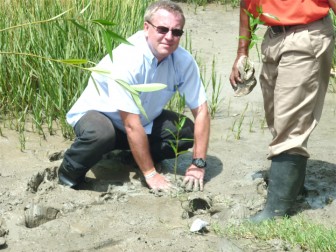Head of the EU Delegation to Guyana Ambassador Robert Kopecky yesterday pledged the support of his office to the mangrove restoration project, during a visit to several sites along the East Coast of Demerara (ECD) where the tropical shrub is being replanted.
The visit by the EU ambassador along with a team from the EU office was aimed at observing the progress of the Mangrove Restoration Project, which is funded jointly by the Government of Guyana and the EU to the tune of €4.1M, equivalent to G$1.1B.

Kopecky told a gathering of officials associated with the project as well as residents of the Golden Grove area who have been supporting the multi-million dollar initiative that the ecological benefits of the project remain vital to the country’s sea defences. He said too that he was now familiarising himself with the project and pledged the support of his office towards the restoration and maintenance of the shrub.
Kopecky visited several areas along the coastline, including the bio-diversity site at Victoria as well as the plant site at Greenfield.
Project Manager Annette Arjoon-Martins noted that the restoration is moving along as planned. She said that the mangrove secretariat was grateful for the Ambassador‘s visit to the project sites and she highlighted the benefits of the project to communities associated with the project.
She said that the second tranche being made available to the project soon may be related to the visit by the EU Ambassador though this was not indicated to the secretariat. Arjoon-Martins said that last year September a first year report on the project was submitted to the authorities and according to her, “we met the required indicators easily and we are now gearing up for the second phase and we have demonstrated that we have protected 10 kilometres, so we are in a position to receive additional funding.”
Meanwhile, Project Coordinator Aditya Persaud said mangrove plants were planted at several areas last year, including from Mon Repos to Felicity, Victoria, Hope and between the Number 6 and Number 8 Villages, on the West Coast of Berbice. He said too that monitoring of project sites is also being done in Region One, while training was undertaken by him and other members of the Secretariat in the area. In Region Two, erosion had affected the plants there but this year more plants will be put down. He said that works are also being undertaken in Region Three and rangers are being hired to protect the plants there. In 2011, Persaud said that 201,000 seedlings were planted along the coastline, covering 4.38km along the coastline. The Secretariat’s budget this year lies in the vicinity of $400M, and remains subject to the approval of Cabinet.
This year, restoration of mangroves will be focused on the Number 8 Village, in Region 5; Greenfield/Beehive in Region 4; and Wellington Park in Region 6. In total, Guyana has 370km of sea defences; including an 80km sea wall and other man-made defences; the remainder is naturally placed.
The project’s aim is to augment Guyana’s sea defence by protecting, restoring and managing the natural coastline provided by mangrove forests. It was initiated in 2010 in support of the government’s Low Carbon Development Strategy (LCDS). According to the Mangrove Secretariat, the cost to build one mile of concrete sea–defence is approximately $9M while the cost to plant a mile of mangroves lies in the vicinity of $150,000.
According to the EU, building and repair of sea defences have long been a priority for funding from the organisation, hence a new programme of protecting and replenishing low cost mangrove cover, which provides a natural defence. Successive European Development Funds (EDF) have put approximately €70M into work on sea defences here and the sum includes €17M, passed under the 9th EDF, where works are under implementation and are expected to be completed by August this year.





